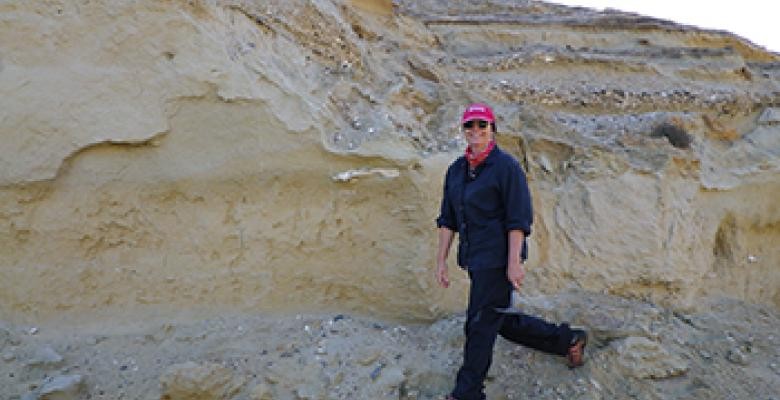Climate Scientist Is First Woman to Win Geology’s Storied Wollaston Medal

A climate scientist who has suggested how mountain building can lower Earth’s thermostat and why ice ages sometimes wax and wane at different speeds has been awarded one of geology’s oldest and most coveted prizes: the British Wollaston Medal. The first woman to win a Wollaston in the prize's 183-year history, Maureen Raymo, a researcher at Columbia University’s Lamont-Doherty Earth Observatory, joins the company of Victorian giants Charles Darwin and Louis Agassiz, and major 20th-century figures including climatologist Sir Nicholas Shackleton and James Lovelock, originator of the Gaia hypothesis. Raymo, 54, will receive the medal, cast in the platinum-like metal palladium discovered by Henry Wollaston in 1803, at the Geological Society of London’s annual meeting in June.
“She is one of the foremost and influential figures in the last 30 years,” said James Scourse, a marine geologist at Bangor University in Wales, who nominated Raymo for the prize. “Wherever you look, you can’t escape papers she has written on some very important question.”
Raised near Boston, in Easton Mass., by a father who taught college physics and wrote popular science books, and a mother who taught children with learning disabilities, Raymo grew up watching ocean explorer Jacques Cousteau on TV and itching to explore the world by land and sea. Drawn by a love of the outdoors, she studied geology at Brown University, followed by work at Lamont-Doherty for her Ph.D. While still in her 20s, she came up with the idea that rising mountain ranges could cool earth’s climate. In what became known as the “uplift-weathering hypothesis,” she and her adviser, William Ruddiman, and coauthor Philip Froelich, proposed that the uplift of the Himalayas and Tibetan plateau, which began 40 million years ago, gave birth to the Indian monsoon and vast amounts of erosion that drew down carbon dioxide from the air, cooling global climate. Still controversial, the hypothesis has generated ongoing research.
Later, as a research professor at Boston University, Raymo came up with an explanation for why ice ages ebbed and flowed more quickly between 3 million and 800,000 years ago—arriving every 41,000 years instead of every 100,000 years as they do today. After watching the documentary March of the Penguins, Raymo started to think about Earth’s orbital cycles, and how expanding ice cover in Antarctica coupled with cyclical changes in the direction of Earth’s rotating axis, might alter the pacing of ice ages. In a 2006 paper in Science, she proposed that the Antarctic ice sheet was far more dynamic in the past than generally accepted.
“Our current understanding of the timing and pace of past ice ages can be traced to Raymo’s intellectual leadership and sheer determination,” said climate scientist Peter deMenocal, chairman of Columbia’s Department of Earth and Environmental Sciences. “Her work remains the gold standard on these questions.”
More recently, Raymo has worked to establish how high the seas rose about 3 million years ago, a time when carbon dioxide levels were similar to today’s, and collapsing ice sheets may have driven sea levels anywhere from 15 feet to 130 feet higher. Armed with GPS and other instruments, Raymo and her colleagues have trekked to Australia, Italy, South Africa, the eastern United States and most recently, Patagonia, to measure past sea-level high stands. After correcting for shoreline movement from tectonic activity and the loading and unloading of ancient ice sheets, she and her team are amassing a continent-by-continent map of where the seas stood. Ultimately, they hope to understand to what extent melting from Greenland and Antarctica contributed to sea-level rise when global average temperatures were 1 to 2 degrees Celsius warmer than today—a mark we could reach by 2100.
Since returning to Lamont in 2011, Raymo has overseen the renovation of the Lamont-Doherty Core Repository, which houses the world’s largest collection of deep sea sediment cores. Stacked to the ceiling in trays, room after room, many of these sediments have contributed to Raymo’s iconic data sets, including the “Lisiecki-Raymo Stack” which provides a 5-million year record of oxygen-isotope levels in the oceans, revealing when ice ages came and went.
A frequent commentator in documentaries and news stories, Raymo is viewed by some as a face to the recent progress women have made in a field still dominated by men. “She’s been an important role model to women scientists—you can get to the top,” said Scourse. “I’ve seen that in my own students, ‘If she can do it, maybe I can too.’”
In other honors, Raymo will receive the 2014 Milutin Milankovic Medal at the European Geosciences Union’s annual meeting in April for marshaling evidence from geochemistry, geology and geophysics to solve paleoclimatology’s big problems. “In an age of progressive research specialization, Raymo remains a model of interdisciplinary research” reads the award citation.
Previous Wollaston medalists from Lamont are: Maurice “Doc” Ewing, Lamont’s founding director, and Wallace Broecker, the Lamont climate scientist credited with first using the term global warming in a scientific paper.